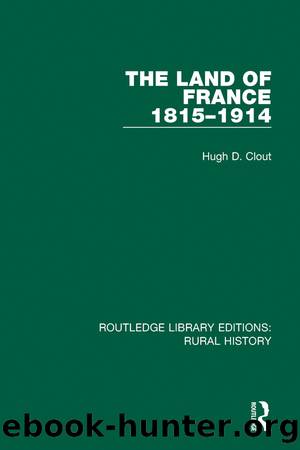The Land of France 1815-1914 by Hugh D. Clout

Author:Hugh D. Clout [Clout, Hugh D.]
Language: eng
Format: epub
Tags: History, General, Europe, France, Modern, 19th Century, 20th Century, Social History, Science, Earth Sciences, Geography
ISBN: 9781351729925
Google: UEgrDwAAQBAJ
Publisher: Routledge
Published: 2017-07-06T04:58:51+00:00
Figure 6.5 (a) Single-shared ploughs as percentage of total, 1892; (b) percentage change in all ploughs, 1852â92; (c) arable surface (ha) per plough, 1892; (d) horses as percentage of draught animals, 1873.
Ploughs of all kinds increased by 44 per cent from 2 292 530 in 1852 to 3 589 480 in 1892, but local trends deviated greatly in response to changes in the number and size of holdings, the amount of land in arable use, the precise form of cropping, and the amount of labour available (Fig. 6.5b). In fact, the number of ploughs recorded in 1892 fell below the 1852 figures in six départements, which ranged from depopulating highlands (Hautes-Alpes, Cantal, Corrèze) to pastoral areas (Calvados, Haute-Saône) and the increasingly urbanised and industrialised Nord. Rates of increase in excess of 75 per cent typified middle France, where land clearance proceeded apace, and parts of the Midi, where arable cultivation experienced some short-lived recovery following the collapse of viticulture that had been provoked by phylloxera.
The ratio of land to ploughs provides a convenient summary of intensity of land occupation, although it must be recognised that larger farms might well have more than one plough apiece (Fig. 6.5c). On average, each plough was being used to cultivate 7 ha of arable land in 1892, with areas more than double that size characterising a dozen northern départements and 18 ha being exceeded in Aisne, Eure-et-Loir, Oise and Meurthe. With the exception of Berry, Poitou and Rouergue, southern France emerged clearly as the realm of petite culture, with less than 3.5 ha of arable land to each plough in a dozen départements of Aquitaine, Dauphiné and Languedoc. Really large farms were the preserve of the northeastern quarter of France, which is where mechanisation might be expected to be particularly attractive.
Horse-drawn hoes were identified in each agricultural enquiry between 1862 (25 055) and 1892 (250 730) and were distributed in a northerly crescent stretching from Poitou through the fringes of Armorica, into Normandy, Artois, Flanders and Lorraine (Fig. 6.5d). In 1862 more than 1000 horse hoes were recorded in Maine-et-Loire, Mayenne, Eure and Pas-de-Calais, with a peak of 2745 in Seine-Inférieure; a second focus involved Basses- and Hautes-Pyrénées, with an outlier in Dauphiné. Thirty years later the northern crescent had expanded throughout Brittany and substantial increases had occurred in Picardy, and in central and southern parts of the Paris Basin. The southern crescent advanced through Languedoc and the lower Rhône to Isère, which had no fewer than 8385 horse hoes in 1892. The successive revival first of arable farming and then of viticulture toward the end of the century doubtless accounted for this trend in the far south.
Download
This site does not store any files on its server. We only index and link to content provided by other sites. Please contact the content providers to delete copyright contents if any and email us, we'll remove relevant links or contents immediately.
Man-made Catastrophes and Risk Information Concealment by Dmitry Chernov & Didier Sornette(5921)
The Revenge of Geography: What the Map Tells Us About Coming Conflicts and the Battle Against Fate by Kaplan Robert D(4034)
Zero Waste Home by Bea Johnson(3777)
COSMOS by Carl Sagan(3553)
Good by S. Walden(3485)
In a Sunburned Country by Bill Bryson(3481)
The Fate of Rome: Climate, Disease, and the End of an Empire (The Princeton History of the Ancient World) by Kyle Harper(3003)
A Wilder Time by William E. Glassley(2818)
Camino Island by John Grisham(2762)
The Ogre by Doug Scott(2631)
Organic Mushroom Farming and Mycoremediation by Tradd Cotter(2626)
Human Dynamics Research in Smart and Connected Communities by Shih-Lung Shaw & Daniel Sui(2465)
Energy Myths and Realities by Vaclav Smil(2437)
The Traveler's Gift by Andy Andrews(2409)
9781803241661-PYTHON FOR ARCGIS PRO by Unknown(2321)
Inside the Middle East by Avi Melamed(2305)
Birds of New Guinea by Pratt Thane K.; Beehler Bruce M.; Anderton John C(2223)
A History of Warfare by John Keegan(2184)
Ultimate Navigation Manual by Lyle Brotherton(2129)
